Click on images to enlarge
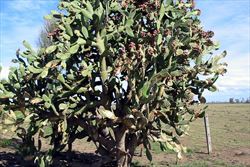
habit (Photo: Sheldon Navie)

stem segments (Photo: Sheldon Navie)

close-up of stem segment from a young plant (Photo: Sheldon Navie)
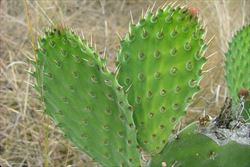
young stem segments with leaves (Photo: Sheldon Navie)

close-up of young stem segment showing hairy surface and tiny leaves (Photo: Sheldon Navie)
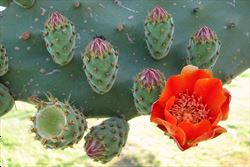
flower buds and flower (Photo: Sheldon Navie)
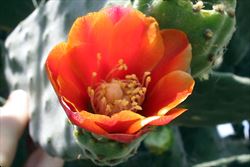
close-up of flower (Photo: Sheldon Navie)
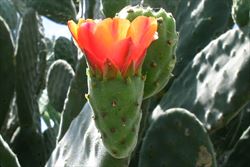
flower from side-on (Photo: Sheldon Navie)
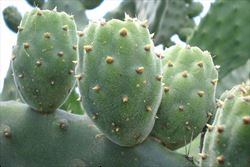
immature fruit (Photo: Sheldon Navie)

mature fruit (Photo: Sheldon Navie)
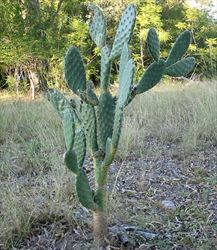
habit of young plant (Photo: Sheldon Navie)

stem segment damaged by the cochineal biocontrol agent (Photo: Sheldon Navie)

stem segment damaged by cactoblastis biocontrol agent (Photo: Sheldon Navie)
Scientific Name
Opuntia tomentosa Salm-Dyck
Synonyms
Opuntia hernandezii DC.Opuntia macdougaliana RoseOpuntia sarca Griffiths ex Scheinvar
Family
Cactaceae
Common Names
prickly pear, tree pear, velvet opuntia, velvet tree pear, velvety tree pear, woollyjoint prickly pear
Origin
Native to Mexico and Guatemala.
Naturalised Distribution
A relatively widespread species that is mostly found in eastern Australia. It is most common in central and southern Queensland. Also present in northern New South Wales and south-eastern South Australia.
Habitat
This species is mostly found in sub-tropical, semi-arid and warmer temperate environments. It is a weed of roadsides, railways, pastures, grasslands, open woodlands, rangelands, disturbed sites and waste areas.
Habit
An upright (i.e. erect), fleshy (i.e. succulent), tree-like plant usually growing 2-6 m tall, but occasionally reaching up to 8 m in height.
Distinguishing Features
- an upright, fleshy, tree-like plant (growing up to 8 m tall) with a single woody main stem at its base.
- its stems are much-branched and consist of a series of flattened segments.
- these stem segments are covered in fine hairs and bear small raised structures that are usually spineless.
- its orange flowers have reddish markings on the outermost 'petals'.
- the fleshy fruit (about 50 mm long and 35 mm wide) turn dull red in colour as they mature.
Stems and Leaves
Its stems are dull green in colour, much-branched, and there is a single thick woody stem at the base of the plant (up to 40 cm thick). The branches consist of a series of flattened (i.e. oblong or elliptic), fleshy (i.e. succulent), stem segments. These stem segments (15-35 cm long, 6-16 cm wide and 15-20 mm thick) are velvety in nature (i.e. finely pubescent) and covered in small raised structures (i.e. areoles) that have clusters of fine yellow bristles (i.e. glochids) 1-5 mm long. The stem segments are usually spineless, but they may occasionally bear groups of one or two grey spines (3-25 mm long). These spines are more prominent on younger plants and tend to be absent from older stem segments.
The leaves are reduced to tiny cylindrical or cone-shaped (i.e. conical) structures. These leaves are also velvety hairy (i.e. finely pubescent) and are quickly shed from the developing stem segments (i.e. they are caducous).
Flowers and Fruit
The bright orange flowers (4-5.5 cm long and 4-5 cm across) usually have reddish coloured markings on the undersides of the outermost petals. They are borne singly on fleshy bases along the margins of the stem segments. Each flower has large numbers of 'petals' (most of these are actually petal-like structures known as petaloids) and numerous stamens. Flowering occurs mostly during spring and summer.
The immature fruit are green in colour, but turn dull red or purplish-red as they mature. These berries (3-5 cm long and 2.5-4 cm wide) are fleshy (i.e. succulent), hairy (i.e. tomentose) and somewhat oval in shape (i.e. ellipsoid or obovoid). They have shallowly depressed tips and are covered with several tufts of small prickly bristles (i.e. glochids). The reddish coloured pulp inside the fruit contains large numbers of somewhat rounded (i.e. sub-globose) pale brown seeds (3-5 mm long).
Reproduction and Dispersal
This species reproduces by stem fragments (i.e. stem segments may become dislodged and produce roots) and also by seeds.
Stem fragments are spread by becoming attached to animals, footwear and vehicles. They are also dispersed in dumped garden waste. The fruit are eaten by various small animals (e.g. birds and foxes) and the seeds spread in their droppings.
Environmental Impact
Velvety tree pear (Opuntia tomentosa) is regarded as an environmental weed in Queensland and New South Wales. It was recently also listed as a priority environmental weed in at least one Natural Resource Management region.
Legislation
This species is declared under legislation in the following states and territories:
- New South Wales: Class 4 - a locally controlled weed. The growth and spread of this species must be controlled according to the measures specified in a management plan published by the local control authority and the plant may not be sold, propagated or knowingly distributed (throughout the entire state). This declaration also applies to all prickly pears (i.e. Opuntia spp.), except Indian fig (i.e. Opuntia ficus-indica).
- Northern Territory: B - growth and spread of this species to be controlled (south of 18°S latitude, in areas outside of towns), and C - not to be introduced into the Territory. This declaration also applies to all prickly pears (i.e. Opuntia spp.).
- Queensland: Class 2 - landowners must take all reasonable steps to keep land free of this species (throughout the entire state). It is also illegal to sell a declared plant or its seed in this state. This declaration also applies to all prickly pears (i.e. Opuntia spp.), except Indian fig (i.e. Opuntia ficus-indica).
- South Australia: 1@ - this species is declared under Class 1c, a classification for prohibited terrestrial plants. It is declared, and its control is required, throughout the entire state. This declaration also applies to all prickly pears (i.e. Opuntia spp.), except Indian fig (i.e. Opuntia ficus-indica).
- Western Australia: P1 - the movement of this species or its seeds is prohibited (for all local authority areas in that part of the state north of the 26th parallel of latitude), P2 - to be eradicated (for all local authority areas in that part of the state north of the 26th parallel of latitude, except for the Exmouth, Carnarvon, Murchison, Upper Gascoyne and Shark Bay local authority areas), and P4 - it must be 'contained' (in the Exmouth, Carnarvon, Murchison, Upper Gascoyne and Shark Bay local authority areas). This declaration also applies to all prickly pears (i.e. Opuntia spp.).
Management
For information on the management of this species see the following resources:
- the Biosecurity Queensland Fact Sheet on prickly pear identification and control, which is available online at http://www.dpi.qld.gov.au.
- the Northern Territory Department of Natural Resources, Environment and The Arts Agnote on this species, which is available online at http://www.nt.gov.au/weeds.
Similar Species
Velvety tree pear (Opuntia tomentosa) is very similar to drooping tree pear (Opuntia monacantha), spiny pest pear (Opuntia dillenii), common prickly pear (Opuntia stricta), Indian fig (Opuntia ficus-indica) and white-spined prickly pear (Opuntia streptacantha). These species can be distinguished by the following differences:
- velvety tree pear (Opuntia tomentosa) is a tall plant that is tree-like in appearance (up to 6 m tall) with flattened and elongated (i.e. oblong or elliptic) stem segments. These stem segments are velvety hairy (i.e. finely pubescent) and do not have any spines on the small raised bumps (i.e. areoles) on their surfaces. It has orange flowers and reddish-purple fruit.
- drooping tree pear (Opuntia monacantha) is a relatively tall shrub or tree-like plant (usually 2-5 m tall) with flattened and elongated (i.e. oblong or obovate) stem segments. These stem segments are hairless and have one or two large spines on most of the small raised bumps (i.e. areoles) on their surfaces. It has yellow flowers and reddish-purple fruit, and some of its stem segments droop towards the ground during fruiting.
- spiny pest pear (Opuntia dillenii) is a low-growing plant (usually 50-100 cm tall) with relatively large flattened and elongated (i.e. elliptic or obovate) stem segments. These stem segments are hairless and have groups of 1-7 large spines on most of the small raised bumps (i.e. areoles) on their surfaces. The flowers are bright yellow and the fruit reddish-purple.
- common prickly pear (Opuntia stricta) is a low-growing plant (usually 50-100 cm tall) with relatively large flattened and elongated (i.e. elliptic or obovate) stem segments. These stem segments are hairless and generally do not have any spines (sometimes one or two large spines are present) on the small raised bumps (i.e. areoles) on their surfaces. The flowers are bright yellow and the fruit reddish-purple.
- Indian fig (Opuntia ficus-indica) is a relatively tall shrubby or tree-like plant (usually 1.5-3 m tall) with very large flattened and elongated (i.e. oblong, elliptic or obovate) stem segments. These stem segments are hairless and do not have any spines on the small raised bumps (i.e. areoles) on their surfaces. It has yellow flowers and reddish coloured fruit.
- white-spined prickly pear (Opuntia streptacantha) is a relatively tall and sometimes tree-like plant (usually 2-4 m tall) with flattened and egg-shaped (i.e. obovate) to almost circular (i.e. orbicular) stem segments. These stem segments are hairless and have groups of 3-20 small white spines on most of the small raised bumps (i.e. areoles) on their surfaces. It has yellow flowers and dull red or yellowish coloured fruit.

